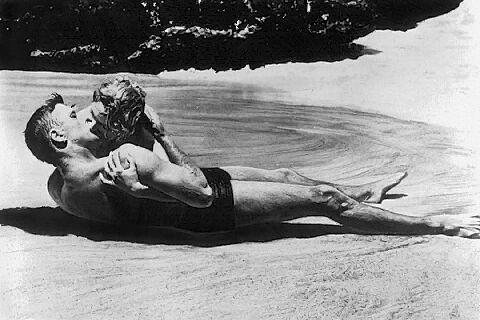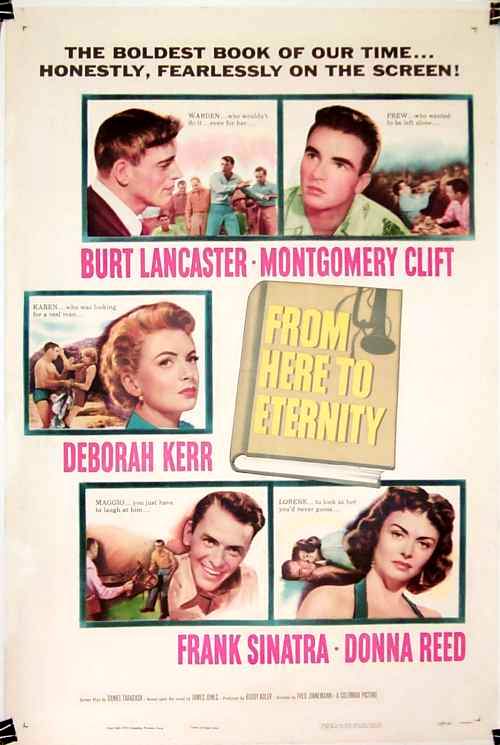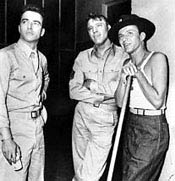|
|
|
Links | Facts for Moviefreaks | Vote for your favorite! | Home |

|
“From Here to Eternity," Columbia Pictures 1953
|

|
Oscar© Winner |

|
A Classic Director Fred Zinnemann "Photos from "From Here to Eternity" The Critics Wrote... “From Here to Eternity.” Life Magazine, August 31, 1953 “The novel seemed to defy every Hollywood taboo. But the film version of “From Here to Eternity” keeps most of its rough characters and much of its mayhem, though the dialog’ is politer. Director Fred Zinnemann gets the performance of their careers out of a stable of stars and splashes on the screen enough of the Jones blend of sex, sentiment, binges, knifings and moral indignation to insure a box-office bonanza.” Honolulu Star Bulletin, January 25, 1954 “...climaxes working up to actual scenes at Pearl Harbor on December 9, 1941. These are so integrated into the continuity that anyone who was around here on that day is apt to chew his fingernails right down to the quick while watching them. If Hollywood has produced anything like this before it doesn’t come to mind. Much of the photography is what people who know about such things probably would call low key.” February 2, 1954 “Even the Army which didn’t like the book, applauded the movie. Reviewers liked it, as evidenced by the 13 Oscar nominations it has received... General Fielder at first thought it would be impossible to build a creditable movie from Jones’s story. “As to the filming of the picture, he said, “military authorities were most concerned over the possibility of a picture that the Communists could use as propaganda.”” Honolulu Advertiser, February 20, 1954 “The Navy has refused to show the films “The Moon Is Blue” and “From Here to Eternity” on its ships and shore stations for “moral” and other reasons, it was disclosed tonight.””... “He (Navy Spokesman) said a high-level conference here in Washington decided not to show “From Here to Eternity” because it was “derogatory of a sister service” -- the army -- and was a “discredit to the armed services.”...”We felt the movie portrayed the military in the wrong light,” he said. “The only woman shown was a serviceman’s wife of obviously low morals or no morals.” “The only recreation shown was getting drunk or patronizing houses of ill fame and the only sport brought up was boxing, and the only reason given for engaging in that was to get promotions. The only officer shown was sadist, and so were the non-coms.” Apollo Guide wrote "While it’s set on the eve of the Pearl Harbor invasion, From Here To Eternity has less to do with the Second World War than it does with the stress of social change – something that was jump-started by the onset of war. Packed with implicit criticism of the military milieu, the film would have been even more controversial if director Fred Zinnemann had been allowed to retain the original ending (in which Captain Holmes is rewarded by the military for his brutishness and incompetence, rather than punished as he is in the final version of the film). But even with that and several other compromises to please the military and buy their co-operation in the movie’s making, this is a powerful film." DVDTalk wrote "Zinnemann just shows two lovers in the surf and is able to suggest hot sex in three cuts and an embrace, and yet get it by the censor. The knife fight in the alley is very realistic for the time, and also untouched by the blue scissor boys. The bombing of Pearl Harbor is sketched with just a few angles near the barracks, newsreels, and stock shots from John Ford's Navy films of WW2, which featured a few re-creations of the attack. Honolulu is represented by the clock tower by the main wharf, and the view of Diamond head from a walkway where you can still sit just where Lancaster did. How drunken and half-beaten soldiers are able to sneak from Honolulu to and from Schofield is something of a mystery, seeing as how they have to be 20 miles distant from one another." |